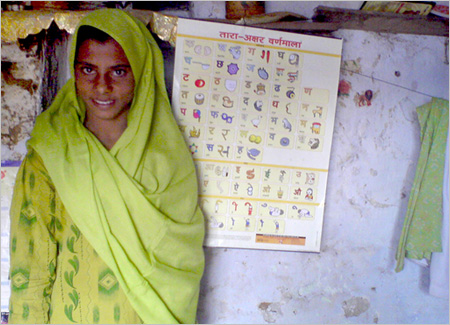|
|
| Help | |
| You are here: Rediff Home » India » India@60 » Real India |
|
Can you imagine surviving on just Rs 20 per day?
Many of us spend many times that amount on maybe a snack every day.
Yet, 836 million people in India live on Rs 20 a day. That's right. 836 million Indians, according to a recent government-commissioned study, live on Rs 20 a day. That is all they can afford.
If it costs more than Rs 20, 77 per cent of this country's population cannot afford it.
This is the unfortunate reality of the resurgent India. Lost in the glowing terms with which we are described in the international media, lost in the glory that India has joined the ranks of the world's economic powers, are India's Real People, to whom the shining malls, the fancy real estate prices, the boom on Dalal Street [Get Quote] makes no difference whatsoever.
What is life for the citizens of the Real India really like? India@60 speaks to them in a new series that we hope will make you -- the fortunate folk who live in the nation's cities and towns, able to easily afford more than Rs 20 a day -- think about the war for survival, the battle to exist until the next day, the struggle to realise the dream for a better life, that is fought in India every day:
 Javeda Abbas, 14
Javeda Abbas, 14Karhera village
Haryana
The roof of the one-roomed hut where Javeda lives is caving in. So precarious is the plank that her family of five has moved to a thatched hut outside. There is no money for repairs, and the last time her father -- a labourer -- got work was over a month ago. Then, too, he only got work for a day.
Three hours from the gleaming malls and throbbing infrastructure of Gurgaon, Javeda's family lives in absolute poverty. It is one in the afternoon and she hasn't eaten. Her first meal of the day will be two rotis for lunch, the tea before sunset will be her dinner.
Down a narrow mud lane, behind a cluster of huts, in her home is an India that still remains in the shadow, untouched by impressive platitudes like an 8% or 9% growth rate.
"On the days Abba gets work, he makes around Rs 80 a day. But work is seasonal. March and April are the best months in the year; the rest of the time, there is no certainty about work," she says, sitting on a rope cot. On its edge is a cloth cradle made from a sari --two ends tied to the bamboo rod of the cot -- inside which lies her sister's infant.
A few years ago, the family had moved out of the village to look for work. Living on a vegetable farm, where all of them worked on the fields, the extra hands brought in urgently needed money. But the work took its toll on Javeda's mother. "The vein in her forehead burst and she died," is Javeda's explanation while a lady beside her says it was typhoid.
Death changed Javeda's life. She had to take on the responsibility of looking after the family. She could never go to school. In the good harvesting months, her father took wheat in lieu of his wages -- grain was more valuable, it could be stored and was cheaper than what was available in the market.
It is that stored wheat that is the mainstay of their meals in the lean months. It is that wheat Javeda is going to eat for lunch today. But, before that as she fans herself with a broken hand fan, she talks about an experience she has never had before.
Last fortnight, she started going to a study centre run by an NGO which is teaching her to read and write. "In these 15 days, I have missed class only on one day because I had to go with my sister to the doctor," she says.
Javeda goes to school after finishing her morning chores and spends two hours there every day. "I want to be able to do something. I hope I can," she says.
While her two older brothers dropped out of school and never went back, Javeda says she enjoys the class. She does not know what she will do after the one-month study programme ends.
At 14, she feels she will be a misfit in a government school, where children her age will be in Class VII or VIII, when her introduction with alphabets began just two weeks ago.
In her poverty, Javeda is a late starter but in a very orthodox Muslim tribal community, it is a huge step for her and many like her. Only one in ten people of her tribe is known to read and write properly.
On the wall of her creaking hut hangs a poster of the Hindi alphabet chart, just below where the roof is on the verge of a collapse. While another part of India prospers and marches on, people like Javeda have been left FAR behind. If this country wants to really regale in the euphoria of a feel-good movie like Chak De, which means 'lift it' -- it is our nation's Javedas that need to be lifted up first.
Text and photograph: Archana Masih
|
|
| © 2007 Rediff.com India Limited. All Rights Reserved. Disclaimer | Feedback |
